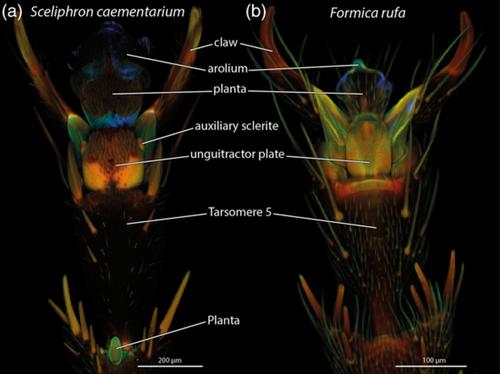当前位置:
X-MOL 学术
›
J. Morphol.
›
论文详情
Our official English website, www.x-mol.net, welcomes your feedback! (Note: you will need to create a separate account there.)
Distal leg structures of the Aculeata (Hymenoptera): A comparative evolutionary study of Sceliphron (Sphecidae) and Formica (Formicidae)
Journal of Morphology ( IF 1.5 ) Pub Date : 2020-05-04 , DOI: 10.1002/jmor.21133 Rolf Georg Beutel 1 , Adrian Richter 1 , Roberto A Keller 2 , Francisco Hita Garcia 3 , Yoko Matsumura 4 , Evan P Economo 3 , Stanislav N Gorb 4
Journal of Morphology ( IF 1.5 ) Pub Date : 2020-05-04 , DOI: 10.1002/jmor.21133 Rolf Georg Beutel 1 , Adrian Richter 1 , Roberto A Keller 2 , Francisco Hita Garcia 3 , Yoko Matsumura 4 , Evan P Economo 3 , Stanislav N Gorb 4
Affiliation

|
The distal parts of the legs of Sceliphron caementarium (Sphecidae) and Formica rufa (Formicidae) are documented and discussed with respect to phylogenetic and functional aspects. The prolegs of Hymenoptera offer an array of evolutionary novelties, mainly linked with two functional syndromes, walking efficiently on different substrates and cleaning the body surface. The protibial‐probasitarsomeral cleaning device is almost always well‐developed. A complex evolutionary innovation is a triple set of tarsal and pretarsal attachment devices, including tarsal plantulae, probasitarsomeral spatulate setae, and an arolium with an internal spring‐like arcus, a dorsal manubrium, and a ventral planta. The probasitarsal adhesive sole and a complex arolium are almost always preserved, whereas the plantulae are often missing. Sceliphron has retained most hymenopteran ground plan features of the legs, and also Formica, even though the adhesive apparatus of Formicidae shows some modifications, likely linked to ground‐oriented habits of most ants. Plantulae are always absent in extant ants, and the arolium is often reduced in size, and sometimes vestigial. The arolium contains resilin in both examined species. Additionally, resilin enriched regions are also present in the antenna cleaners of both species, although they differ in which of the involved structures is more flexible, the calcar in Sceliphron and the basitarsal comb in Formica. Functionally, the hymenopteran distal leg combines (a) interlocking mechanisms (claws, spine‐like setae) and (b) adhesion mechanisms (plantulae, arolium). On rough substrate, claws and spine‐like setae interlock with asperities and secure a firm grip, whereas the unfolding arolium generates adhesive contact on smooth surfaces. Differences of the folded arolium of Sceliphron and Formica probably correlate with differences in the mechanism of folding/unfolding.
中文翻译:

Aculeata(膜翅目)的远端腿结构:Sceliphron(Sphecidae)和Formica(Formicidae)的比较进化研究
Sceliphron caementarium (Sphecidae) 和 Formica rufa (Formicidae) 腿的远端部分被记录并讨论了系统发育和功能方面。膜翅目的前肢提供了一系列进化新奇,主要与两种功能综合征有关,在不同的基质上有效地行走和清洁体表。protibial-probasitarsomeral 清洁装置几乎总是很发达。一个复杂的进化创新是一组三组跗骨和前跗骨附着装置,包括跗骨、前鼻小体铲状刚毛,以及具有内部弹簧状弓、背侧柄和腹侧足底的 arolium。长鼻黏附性鞋底和复杂的翼状体几乎总是被保留下来,而跖骨则经常缺失。Sceliphron 保留了大多数膜翅目昆虫的腿和 Formica 的地面特征,尽管蚁科的粘附装置显示出一些变化,这可能与大多数蚂蚁的地面习惯有关。现存的蚂蚁中总是不存在 Plantulae,并且 arolium 的大小通常会减小,有时甚至会退化。在两个被检测的物种中,arolium 都含有弹性蛋白。此外,两种物种的天线清洁器中也存在富含弹性蛋白的区域,尽管它们在所涉及的结构中哪个更灵活、Sceliphron 中的距骨和 Formica 中的基底梳中有所不同。在功能上,膜翅目远端腿结合了(a)互锁机制(爪、棘状刚毛)和(b)粘附机制(植物、arolium)。在粗糙的基材上,爪子和棘状刚毛与凹凸不平并确保牢固抓握,而展开的罗兰在光滑的表面上产生粘合接触。Sceliphron 和 Formica 的折叠 arolium 的差异可能与折叠/展开机制的差异有关。
更新日期:2020-05-04
中文翻译:

Aculeata(膜翅目)的远端腿结构:Sceliphron(Sphecidae)和Formica(Formicidae)的比较进化研究
Sceliphron caementarium (Sphecidae) 和 Formica rufa (Formicidae) 腿的远端部分被记录并讨论了系统发育和功能方面。膜翅目的前肢提供了一系列进化新奇,主要与两种功能综合征有关,在不同的基质上有效地行走和清洁体表。protibial-probasitarsomeral 清洁装置几乎总是很发达。一个复杂的进化创新是一组三组跗骨和前跗骨附着装置,包括跗骨、前鼻小体铲状刚毛,以及具有内部弹簧状弓、背侧柄和腹侧足底的 arolium。长鼻黏附性鞋底和复杂的翼状体几乎总是被保留下来,而跖骨则经常缺失。Sceliphron 保留了大多数膜翅目昆虫的腿和 Formica 的地面特征,尽管蚁科的粘附装置显示出一些变化,这可能与大多数蚂蚁的地面习惯有关。现存的蚂蚁中总是不存在 Plantulae,并且 arolium 的大小通常会减小,有时甚至会退化。在两个被检测的物种中,arolium 都含有弹性蛋白。此外,两种物种的天线清洁器中也存在富含弹性蛋白的区域,尽管它们在所涉及的结构中哪个更灵活、Sceliphron 中的距骨和 Formica 中的基底梳中有所不同。在功能上,膜翅目远端腿结合了(a)互锁机制(爪、棘状刚毛)和(b)粘附机制(植物、arolium)。在粗糙的基材上,爪子和棘状刚毛与凹凸不平并确保牢固抓握,而展开的罗兰在光滑的表面上产生粘合接触。Sceliphron 和 Formica 的折叠 arolium 的差异可能与折叠/展开机制的差异有关。


























 京公网安备 11010802027423号
京公网安备 11010802027423号